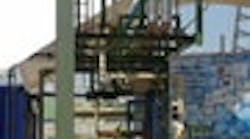Proton exchange membrane (PEM) fuel cells offer chlor-alkali makers the opportunity to extract value from byproduct hydrogen without any compression or transportation costs. The hydrogen simply is converted into electricity on the spot.
The technology is reliable and requires little maintenance. The PEM fuel cells (Figure 1) run at a lower temperature and pressure than others, which contributes to trouble-free operation as well as low parasitic losses. In addition, ramp-up and ramp-down are quick and easy and can occur frequently.
PEM-fuel-cell stacks boast compelling economics for chlor-alkali sites with an excess flow of hydrogen that currently isn't fully monetized. The value of heat and power combined must exceed €80/MWh.
SUCCESSFUL TRIAL SPURS ADOPTION
PEM fuel cell stacks provide backup power for telecommunications and utility companies but hadn't been installed in industrial plants. In 2007, AkzoNobel, Amsterdam, became the first chlorine producer to use PEM fuel cells, directly coupling them to its chlorine plant in the Netherlands. That unit still is operating.
The trial has proven the technology fit for industrial use and suitable as a source of primary power from hydrogen. The so-called PEM power plant has operated for more than four years without any interference with the chlor-alkali process. Moreover, the PEM power plant's performance has increased over the years. Its power output has risen by 20%, its availability stands at over 95%, and degradation of the conversion efficiency is now less than 5% per 10,000 hours of operation.
The success of this pilot plant has prompted other chlorine and chlorate producers to approach Nedstack for full-scale units. As a result, the first 1-MW PEM power plant (Figure 2) was installed during the summer of 2011 at Solvay's chlorine plant at Lillo, near Antwerp, Belgium.
EASY INSTALLATION
At AkzoNobel and Solvay, the PEM power plant was fitted to the existing chlorine plant without any modifications to the production process. The skid-mounted unit only requires the following tie-ins:
Hydrogen. The gas comes straight from the chlorine electrolyzer and is washed inside the PEM power plant, to remove traces of caustic soda. The stacks convert the hydrogen to produce pure water, which is fed back into the chlorine production process.
Nitrogen. This inert gas is utilized to purge the fuel cells during the automatic shutdown procedure.
Cooling water. A 1-MW PEM power plant produces about one MW of heat, which is transferred to the cooling water, raising its temperature to as high as 70°C. This heat can be used elsewhere onsite, for example, to preheat brine.
Power grid. The fuel cells produce one MW of DC power. So, the PEM power plant includes inverters and transformers to provide AC power (Solvay uses 6 kV) for feeding into the grid.
Communication. The plant's local area network handles data and control.
About the company: Nedstack, which was spun off from AkzoNobel in 1998, now is the biggest independent PEM-fuel-cell producer in Europe and the second largest worldwide. It sells its fuel cell stacks to system integrators.
OLIVIER SCHEELE is CEO of Nedstack, Arnhem, the Netherlands. E-mail him at [email protected].


